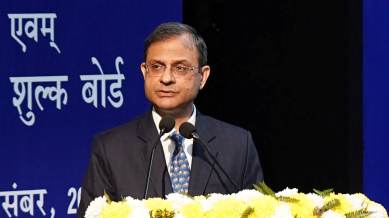Monetary policy needs to remain watchful amid uncertainty on the external front, says RBI Governor Malhotra
In the August policy, the RBI’s six-member MPC unanimously voted to leave the policy repo rate unchanged at 5.5 per cent and maintain the policy stance as ‘neutral’.

Given the current uncertainties related to tariffs and due to geopolitical tensions, monetary policy needs to be ‘watchful’, Reserve Bank of India Governor Sanjay Malhotra wrote in the minutes of the Monetary Policy Committee (MPC) meeting held on August 4-6.
In the August policy, the RBI’s six-member MPC unanimously voted to leave the policy repo rate unchanged at 5.5 per cent and maintain the policy stance as ‘neutral’.
“The current state of uncertainty on the external front, monetary policy needs to remain watchful. Therefore, I vote to keep the policy repo rate unchanged at 5.50 per cent,” Malhotra wrote in the policy minutes released on Thursday.
He said the neutral stance would provide monetary policy the necessary flexibility to respond to the evolving domestic and global economic conditions.
Late last month, US President Donald Trump announced a 25 per cent tariff on all goods imported from India, which was later doubled to 50 per cent for buying Russian oil and arms.
“Uncertainty in external demand, driven by tariff and geopolitical uncertainty, remains the major drag on growth as it also hinders private investment intentions, which is yet to show visible signs of improvement,” the governor said.
Malhotra wrote that despite uncertainties, the Indian economy continues to demonstrate strength, stability and opportunity. “India’s strong fundamentals, growth inducing policies, and forward-looking economic strategy clearly place it in a strong position,” he said.
The governor said that GDP growth projection of 6.5 per cent reflects resilience, though it remains lower than what the economy can achieve. He expects growth to be supported by favourable supply-side factors as well as a supportive policy environment during the remaining part of the fiscal.
In the policy, the RBI lowered its Consumer Price Index (CPI) inflation forecast for the current fiscal by 60 basis points (bps) to 3.1 per cent, compared to an earlier estimate of 3.7 per cent. In July, inflation fell to an eight-year low of 1.55 per cent, compared to 2.1 per cent in the previous month.
The governor said the inflation outcomes have been far more benign on account of higher food price moderation.
“Although we are likely to see inflation undershooting the target in the near term, with a likelihood of monthly numbers even crossing the lower tolerance band of 2 per cent, headline inflation is projected to inch up from Q3 onwards. The uncertainties of tariffs are still evolving,” he said. The RBI has projected CPI inflation to be at 3.1 per cent in Q3 FY26 and 4.4 per cent in Q4 FY26.
MPC member and RBI Deputy Governor Poonam Gupta said she does not see the scope or rationale for a further policy rate cut at this point taking into account the growth-inflation outlook, past actions, the state of the domestic economy, and the global dynamics.
One of the external MPC members, Saugata Bhattacharya, wrote that the outcome and timelines of a bilateral trade deal with the US are unclear. If these tariffs persist, there is likely to be an adverse impact on India’s growth in FY26, and probably beyond, he said.
MPC member and RBI Executive Director Rajiv Ranjan wrote that the effects of the 100 bps rate cut since February 2025 are still working through the system, and transmission to credit markets is ongoing.
“Thus, it is prudent at the current juncture to adopt a wait-and-watch approach to see the extent of transmission before delivering further policy stimulus,” Ranjan said.
MPC external member Ram Singh said given the high degree of uncertainty regarding growth and the volatile nature of food inflation, caution is warranted in the rate cut.
“To respond to an unpredictable set of events, it is crucial to maintain policy options, in terms of the number of policy tools that can be used as well as their force,” Singh wrote in the minutes.
Another external MPC member, Nagesh Kumar, said, “While the case for stimulating private investments and urban demand remains, and the benign inflation outlook provides policy space, we may wish to wait and watch as the transmission of the existing actions takes place and how the trade policy uncertainties play out before considering policy actions at the October meeting of the MPC.”